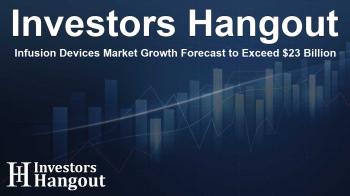Infusion Devices Market Growth Forecast to Exceed $23 Billion

Infusion Devices Market Overview
The infusion devices market is projected to experience substantial growth, aiming to reach an impressive US$ 23.08 billion by 2031, an increase from US$ 13.73 billion in 2023. This growth signifies a compound annual growth rate (CAGR) of 6.7% during the forecast period. The increasing prevalence of chronic diseases, alongside technological advances in infusion therapy, shapes the landscape of this dynamic market.
Significance of Infusion Devices in Healthcare
Infusion devices play a crucial role in modern medicine, facilitating the delivery of medications, nutrients, and fluids directly into a patient's body. These devices are essential for administering treatments, particularly in oncology and chronic disease management. They allow healthcare professionals to maintain precise control over fluid and drug administration, which is vital for ensuring patient safety across multiple healthcare settings.
Rising Incidence of Chronic Diseases
One primary driver of market expansion is the escalating incidence of diseases such as cancer, diabetes, and cardiovascular conditions. According to health organizations, a significant portion of global cancer cases is attributable to breast, lung, colorectal, and prostate cancers, accounting for nearly half of new diagnoses annually. The World Health Organization's recent data highlights that millions are affected, with projections indicating this trend will continue, increasing demand for interventions such as chemotherapy that rely on infusion devices.
Market Dynamics and Strategic Initiatives
The infusion devices market is witnessing transformational changes, particularly with advancements in technology and evolving consumer needs. Major players in the industry are actively pursuing strategic initiatives—including product innovations, mergers, and partnerships—to enhance their offerings.
Recent Developments in Infusion Technologies
- The introduction of the BD Alaris EMR Interoperability system, enhancing the communication between IV pumps and electronic medical records, streamlining processes, and reducing administration errors.
- Mindray's launch of the BeneFusion i Series and u Series infusion systems epitomizes innovation, designed for safety and efficacy in medication delivery.
- Medtronic's Extended infusion set has achieved FDA clearance, enabling up to seven-day wear time, representing a leap forward in infusion therapy convenience for patients.
- Fresenius Kabi received regulatory clearance for its Agilia Connect Infusion System, promoting wireless technology in medical infusions, which aligns with modern healthcare needs.
Geographical Insights into Market Growth
In terms of revenue, North America currently leads the infusion devices market, closely followed by Europe and the Asia-Pacific region. The Asia-Pacific market is anticipated to show exceptional growth dynamics, attributed to rapid technological adoption and a rising aging population requiring sophisticated healthcare solutions.
Competitive Landscape
Key players reshaping the infusion devices market include Becton Dickinson and Co, Fresenius Kabi AG, Baxter International Inc., and Medtronic Plc among others. These companies demonstrate a commitment to enhancing patient outcomes and driving innovation. Their focus on research and development fuels the introduction of cutting-edge devices that promise to improve healthcare delivery.
Future Trends in the Infusion Devices Market
The future of the infusion devices market looks promising, driven by ongoing advancements in technology and the rising incidence of chronic diseases. The shift towards home healthcare solutions further supports market growth, as patients increasingly seek outpatient therapies that offer convenience and flexibility. Stakeholders across the healthcare spectrum—ranging from manufacturers to providers—are positioned to capitalize on emerging opportunities within this sector.
Conclusion
In summary, the infusion devices market represents a vital component of the healthcare framework, underscored by the pressing need for innovative drug delivery systems. As market trajectories indicate sustained growth, ongoing technological advancements and strategic market initiatives will play pivotal roles in enhancing patient care and improving therapeutic efficacy.
Frequently Asked Questions
What is the projected size of the infusion devices market?
The infusion devices market is expected to reach US$ 23.08 billion by 2031.
What factors are driving growth in the infusion devices market?
Key drivers include the increasing prevalence of chronic diseases, advancements in technology, and a growing shift towards home healthcare solutions.
Who are the major players in the infusion devices market?
Notable companies include Becton Dickinson and Co, Fresenius Kabi AG, Baxter International Inc., and Medtronic Plc.
What are some recent advancements in infusion devices?
Recent innovations include interoperable IV pumps, advanced infusion systems by Mindray, and Medtronic’s extended wear infusion sets.
How is the regional market growth distributed?
North America leads the market, with significant growth expected in the Asia-Pacific region due to increasing healthcare demands.
About The Author
Contact Kelly Martin privately here. Or send an email with ATTN: Kelly Martin as the subject to contact@investorshangout.com.
About Investors Hangout
Investors Hangout is a leading online stock forum for financial discussion and learning, offering a wide range of free tools and resources. It draws in traders of all levels, who exchange market knowledge, investigate trading tactics, and keep an eye on industry developments in real time. Featuring financial articles, stock message boards, quotes, charts, company profiles, and live news updates. Through cooperative learning and a wealth of informational resources, it helps users from novices creating their first portfolios to experts honing their techniques. Join Investors Hangout today: https://investorshangout.com/
The content of this article is based on factual, publicly available information and does not represent legal, financial, or investment advice. Investors Hangout does not offer financial advice, and the author is not a licensed financial advisor. Consult a qualified advisor before making any financial or investment decisions based on this article. This article should not be considered advice to purchase, sell, or hold any securities or other investments. If any of the material provided here is inaccurate, please contact us for corrections.

